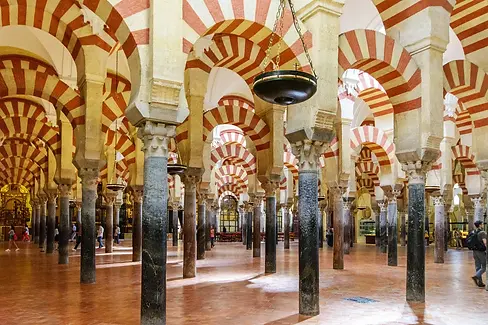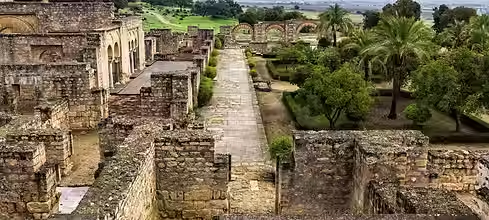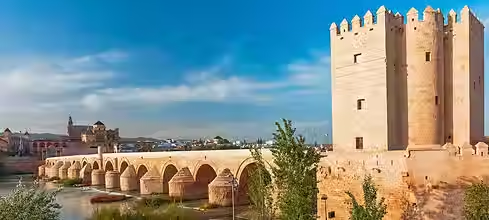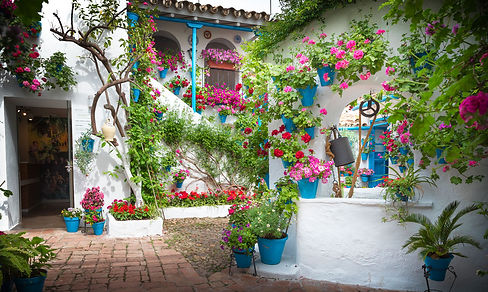Cordoba
Córdoba is a city where the legacy of Al-Andalus lives on in every stone, arch, and narrow street. Once the capital of the Islamic Caliphate in Spain, it was one of the most advanced cities in the world — a center of knowledge, culture, and coexistence. Today, Córdoba invites Muslim travelers to reconnect with that golden past. The city’s crown jewel is the Great Mosque of Córdoba (Mezquita), a breathtaking symbol of Islamic architecture that continues to inspire awe. Wander through the whitewashed alleyways of the Jewish Quarter, stroll across the Roman Bridge, and discover the Calahorra Tower, home to the Museum of Al-Andalus. Just outside the city lies Medina Azahara, the ruins of the once-magnificent palatial city built by the Umayyads. Córdoba also offers halal dining options and mosques for prayer, making it a comfortable and welcoming destination for Muslims. The peaceful patios, historic hammams, and beautiful courtyards create an atmosphere of reflection and serenity. With Mazhoud Halal Tourism, explore Córdoba with deep cultural insight, spiritual ease, and personalized guidance. This is not just a visit — it’s a return to your heritage in the heart of Andalusia.
Sights in Cordoba
Great Mosque of Cordoba
Cordova’s most breathtaking landmark and a masterpiece of Islamic and Christian architecture. Built in the 8th century as a grand mosque and later converted into a cathedral, it showcases a mesmerizing forest of red-and-white horseshoe arches, intricate mihrabs, and a blend of Moorish, Gothic, Renaissance, and Baroque styles. Walking through its vast interior is like stepping back in time, witnessing centuries of cultural and religious fusion. The bell tower, once a minaret, offers panoramic views of the city.


Caliphal City of Medina Azahara
Located just outside Cordova, Medina Azahara was a luxurious palace-city built by Caliph Abd al-Rahman III in the 10th century to showcase the power of Al-Andalus. The city featured grand halls, intricate gardens, and exquisite Islamic art. Though it was destroyed in the 11th century, its ruins still reveal the splendor of the Umayyad dynasty. A UNESCO World Heritage Site, Medina Azahara offers a fascinating glimpse into medieval Islamic civilization, with an on-site museum that helps visitors imagine its former glory.
The Jewish Quarter of Cordoba
Cordoba’s Jewish Quarter is a beautifully preserved neighborhood that transports visitors to the Middle Ages. Narrow cobbled streets, whitewashed houses, and flower-filled patios create a charming atmosphere. The highlight is the 14th-century Cordova Synagogue, one of the few remaining medieval synagogues in Spain. Nearby, the Casa de Sefarad museum provides insight into Sephardic Jewish heritage. This area reflects the city’s historical coexistence of Muslim, Jewish, and Christian communities, making it an essential stop for history lovers.


Roman Bridge and
Calahorra Tower
Originally built in the 1st century BC by the Romans, this iconic bridge spans the Guadalquivir River and has been reconstructed several times over the centuries. Walking across it offers stunning views of the Mezquita-Catedral and the old city. At the southern end of the bridge stands the Calahorra Tower, a medieval fortress that now houses the Museum of Al-Andalus Life, which explores the cultural legacy of Muslim, Christian, and Jewish influences in Spain. Illuminated at night, the bridge is one of the most picturesque spots in Cordoba.
Patios of Cordoba
Córdoba’s Patios Festival (Fiesta de los Patios) is one of Spain’s most unique cultural traditions. Every May, locals open their beautifully decorated courtyards to the public, showcasing a dazzling display of colorful flowers, ornate tiles, and traditional Andalusian architecture. These patios, found in historic homes, reflect the Moorish influence on Córdoba’s urban design, where courtyards provided cool retreats from the summer heat. Recognized as Intangible Cultural Heritage by UNESCO, the festival is a must-see for visitors who want to experience the city's vibrant local culture.




